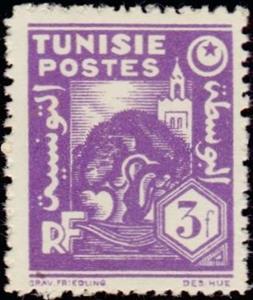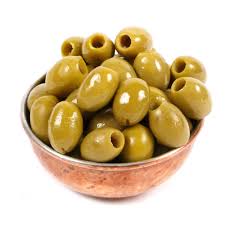Stamp: Olivier and Mosque (Tunisia 1944)
Olivier and Mosque (Tunisia 1944)
01 January (Tunisia ) within release Definitive Issue goes into circulation Stamp Olivier and Mosque face value 3 Tunisian franc
| Stamp Olivier and Mosque in catalogues | |
|---|---|
| Michel: | Mi:TN 272 |
| Yvert et Tellier: | Yt:TN 260 |
Stamp is square format.
Also in the issue Definitive Issue:
- Stamp - Olives and Mosque face value 0.30;
- Stamp - Olivier and Mosque face value 0.40;
- Stamp - Olivier and Mosque face value 0.60;
- Stamp - Olivier and Mosque face value 0.70;
- Stamp - Olivier and Mosque face value 0.80;
- Stamp - Olivier and Mosque face value 0.90;
- Stamp - Olivier and Mosque face value 1;
- Stamp - Olivier and Mosque face value 1.50;
- Stamp - Olivier and Mosque face value 2.40;
- Stamp - Olivier and Mosque face value 2.50;
- Stamp - Olivier and Mosque face value 3;
- Stamp - Olivier and Mosque face value 4;
- Stamp - Olivier and Mosque face value 4.50;
- Stamp - Olivier and Mosque face value 5;
- Stamp - Olivier and Mosque face value 6;
- Stamp - Olivier and Mosque face value 10;
- Stamp - Olivier and Mosque face value 15;
- Stamp - Olivier and Mosque face value 20;
|
Data entry completed
46%
|
|
|---|---|
| Stamp Olivier and Mosque in digits | |
| Country: | Tunisia |
| Date: | 1944-01-01 |
| Perforation: | 11½ |
| Format: | Stamp |
| Face Value: | 3 Tunisian franc |
Stamp Olivier and Mosque it reflects the thematic directions:
In botany, a tree is a perennial plant with an elongated stem, or trunk, supporting branches and leaves in most species. In some usages, the definition of a tree may be narrower, including only woody plants with secondary growth, plants that are usable as lumber or plants above a specified height. Trees are not a taxonomic group but include a variety of plant species that have independently evolved a woody trunk and branches as a way to tower above other plants to compete for sunlight. In looser senses, the taller palms, the tree ferns, bananas and bamboos are also trees. Trees tend to be long-lived, some reaching several thousand years old. The tallest known tree, a coast redwood named Hyperion, stands 115.6 m (379 ft) high. Trees have been in existence for 370 million years. It is estimated that there are just over 3 trillion mature trees in the world. A tree typically has many secondary branches supported clear of the ground by the trunk. This trunk typically contains woody tissue for strength, and vascular tissue to carry materials from one part of the tree to another. For most trees it is surrounded by a layer of bark which serves as a protective barrier. Below the ground, the roots branch and spread out widely; they serve to anchor the tree and extract moisture and nutrients from the soil. Above ground, the branches divide into smaller branches and shoots. The shoots typically bear leaves, which capture light energy and convert it into sugars by photosynthesis, providing the food for the tree's growth and development. Flowers and fruit may also be present, but some trees, such as conifers, instead have pollen cones and seed cones; others, such as tree ferns, produce spores instead. Trees play a significant role in reducing erosion and moderating the climate. They remove carbon dioxide from the atmosphere and store large quantities of carbon in their tissues. Trees and forests provide a habitat for many species of animals and plants. Tropical rainforests are one of the most biodiverse habitats in the world. Trees provide shade and shelter, timber for construction, fuel for cooking and heating, and fruit for food as well as having many other uses. In parts of the world, forests are shrinking as trees are cleared to increase the amount of land available for agriculture. Because of their longevity and usefulness, trees have always been revered, with sacred groves in various cultures, and they play a role in many of the world's mythologies.
Mosquitoes, the Culicidae, are a family of small flies consisting of 3,600 species. The word mosquito (formed by mosca and diminutive -ito) is Spanish and Portuguese for little fly. Mosquitoes have a slender segmented body, one pair of wings, three pairs of long hair-like legs, and specialized, highly elongated, piercing-sucking mouthparts. All mosquitoes drink nectar from flowers; females of some species have in addition adapted to drink blood. The group diversified during the Cretaceous period. Evolutionary biologists view mosquitoes as micropredators, small animals that parasitise larger ones by drinking their blood without immediately killing them. Medical parasitologists view mosquitoes instead as vectors of disease, carrying protozoan parasites or bacterial or viral pathogens from one host to another.
The olive, botanical name Olea europaea, meaning 'European olive', is a species of small tree or shrub in the family Oleaceae, found traditionally in the Mediterranean Basin, with wild subspecies found further afield in Africa and western Asia. When in shrub form, it is known as Olea europaea 'Montra', dwarf olive, or little olive. The species is cultivated in all the countries of the Mediterranean, as well as in Australia, New Zealand, North and South America and South Africa. It is the type species for its genus, Olea. The tree and its fruit give their name to the Oleaceae plant family, which also includes species such as lilac, jasmine, forsythia, and the true ash tree.


